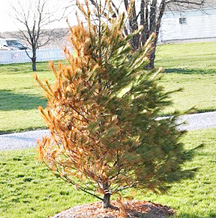Chesapeake Bay's Independent Newspaper ~ Since 1993
1629 Forest Drive, Annapolis, MD 21403 ~ 410-626-9888
Volume xviii, Issue 10 ~ March 11 - March 17, 2010
Home \\ Correspondence \\ from the Editor \\ Submit a Letter \\ Classifieds \\ Contact Us
Best of the Bay \\ Dining Guide \\ Home & Garden Guide \\ Archives \\ Distribution \\ Advertising![]()


Bay Gardener |
The Consequences of Cold
We haven’t seen the end of Old Man Winter’s wrath
I predict that this spring we will be seeing many symptoms of winter injury to plants.
On the night of January 31, I measured a temperature of 10 degrees at Upakrik Farm in Deale. During the week of January 24 to January 30, I measured four nights when temperatures dropped to 14 degrees. These cold temperatures are sufficient to kill flower buds of the more tender crops.
The combination of cold temperatures, frozen ground and the strong reflective properties of snow are the ideal combination for scalding foliage of some broadleaf evergreens. Scalding is due to high light intensity, frozen stems, constant winds and marginally hardy plants. Winter damage is one of the main causes limiting the distribution of plants in cold climates.
![]()
 I would not be surprised if most of the figs are killed to the ground. The foliage of rhododendrons, camellias, some evergreen hollies, cherry laurel, evergreen euonymus and boxwoods will exhibit marginal burn with severe discoloration. The flower buds of some of the more tender azaleas such as Encore as well as flower buds of Camellia Japonica will be killed and have only limited bloom.
I would not be surprised if most of the figs are killed to the ground. The foliage of rhododendrons, camellias, some evergreen hollies, cherry laurel, evergreen euonymus and boxwoods will exhibit marginal burn with severe discoloration. The flower buds of some of the more tender azaleas such as Encore as well as flower buds of Camellia Japonica will be killed and have only limited bloom.
Home gardeners who are growing woody plants in above ground containers are likely to find that the plants will be dead by spring. The roots of plants are not so cold-hardy as are the stems and leaves. Since the containers are above ground, the temperatures in the growing medium in those containers will be similar to ambient air. This means that if temperatures drop to 10 degrees by midnight, the growing medium within those containers will equilibrate to ambient air within three to four hours. The roots of hollies, boxwoods, cherry laurel, yews, and many more will be killed. However, the roots of junipers, pine, spruce and fir trees and shrubs will survive temperatures of 10 degrees. If the growing medium is dry, there is likely to be more root kill than if the growing medium is wet.
I am hoping that we had sufficient cold to severely damage kudzu. The winter of 1976-77 did severe damage to kudzu growing in Prince George’s and Montgomery counties. However, as one can easily see, kudzu has made a complete recovery. If kudzu is severely damaged by this winter’s cold temperature, now’s the time to attack it with additional chemicals to eradicate it.
Next week brings us spring, and the Bay Gardener’s advice for salvaging winter-injured plants.
Ask Dr. Gouin your questions at [email protected]. All questions will appear in Bay Weekly. Please include your name and address.
© COPYRIGHT 2010 by New Bay Enterprises, Inc. All rights reserved.
